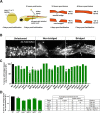CRISPR gRNA phenotypic screening in zebrafish reveals pro-regenerative genes in spinal cord injury
- PMID: 33914736
- PMCID: PMC8084196
- DOI: 10.1371/journal.pgen.1009515
CRISPR gRNA phenotypic screening in zebrafish reveals pro-regenerative genes in spinal cord injury
Abstract
Zebrafish exhibit robust regeneration following spinal cord injury, promoted by macrophages that control post-injury inflammation. However, the mechanistic basis of how macrophages regulate regeneration is poorly understood. To address this gap in understanding, we conducted a rapid in vivo phenotypic screen for macrophage-related genes that promote regeneration after spinal injury. We used acute injection of synthetic RNA Oligo CRISPR guide RNAs (sCrRNAs) that were pre-screened for high activity in vivo. Pre-screening of over 350 sCrRNAs allowed us to rapidly identify highly active sCrRNAs (up to half, abbreviated as haCRs) and to effectively target 30 potentially macrophage-related genes. Disruption of 10 of these genes impaired axonal regeneration following spinal cord injury. We selected 5 genes for further analysis and generated stable mutants using haCRs. Four of these mutants (tgfb1a, tgfb3, tnfa, sparc) retained the acute haCR phenotype, validating the approach. Mechanistically, tgfb1a haCR-injected and stable mutant zebrafish fail to resolve post-injury inflammation, indicated by prolonged presence of neutrophils and increased levels of il1b expression. Inhibition of Il-1β rescues the impaired axon regeneration in the tgfb1a mutant. Hence, our rapid and scalable screening approach has identified functional regulators of spinal cord regeneration, but can be applied to any biological function of interest.
Conflict of interest statement
I have read the journal’s policy and the authors of this manuscript have the following competing interests: [DG and HHT are employees and shareholders of Biogen]
Figures



References
-
- Becker T, Becker CG. Dynamic cell interactions allow spinal cord regeneration in zebrafish. Curr Opin Physiol. 2020;10.1016/j.cophys.2020.01.009. - DOI
Publication types
MeSH terms
Substances
Grants and funding
LinkOut - more resources
Full Text Sources
Other Literature Sources
Molecular Biology Databases
Miscellaneous

